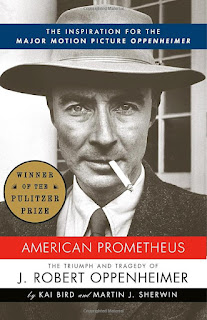Book American Prometheus: The Triumph and Tragedy of J. Robert Oppenheimer
The Book review is in our parts
Interaction of Oppenheimer with top Physicists
Interaction of Oppenheimer with top Physicists
In the book American Prometheus, the authors write that Oppenheimer was "a magnet for brilliant people." He was able to attract and inspire some of the best minds in physics, and he created a culture of creativity and innovation at Los Alamos.
The scientists that Oppenheimer met and worked with had a profound impact on his life and career. They helped him to develop his own scientific thinking, and they inspired him to use his knowledge to make a difference in the world. The book is meticulously researched and compelling biography that offers a deep exploration of the life of a brilliant scientist who played a pivotal role in shaping the modern world.. The book also makes a commentary of political witch-hunting and the impact of the injustice. This book stands as a testament to the power and potential pitfalls of science in the service of humanity and the enduring impact of one man’s choices on the course of history. He never fully recovered from the fallout of the security clearance hearing.
The last years of Oppenheimer’s life just seem to peter out in this biography. He spent much of his time on a Caribbean island and did little or no scientific work. Perhaps this is the tragedy Bird and Sherwin have in mind. Perhaps they are suggesting that McCarthyism killed Oppenheimer’s creativity, though they do not quite say so.
The biography portrays Oppenheimer as a complex figure, torn between his dedication to science, his political beliefs, and the intense pressures of his time. Also Oppenhiemer was very versatile pursuing a wide set of his interests and hobbies in full depth
Here is a brief summary form the biography about Oppenheimer's life before his leading the Manhattan Project, as this part of his life is not covered in the film. (see the review )
Part II : Summary of years before the Manhattan Project
Childhood and adolescence: Chapters 1 and 2
The biography opens with an exploration of Oppenheimer’s early life, depicting him as a brilliant and precocious child growing up in a wealthy New York family. It highlights his intellectual curiosity, his love for literature, and his early exposure to progressive political ideas. Oppenheimer’s education at elite institutions like Harvard and the University of Cambridge paved the way for his impressive academic career.
It is important to understand Oppenhiemer's previleged childhood to understand his progressive and liberal views. Hoping to give him the best education possible, Oppenheimer's parents sent him to the famous New York School for Ethical Culture, which he attended from second grade through his graduation from high school. he school was run by another European émigré who also was founder of the NAACP. By the time he graduated, Oppenheimer could speak five languages and had gained a lifelong passion for art, literature, and philosophy.
He went to Harvard, eCavendish Laboratory at Cambridge University, one of the best nuclear physics labs in the world.
In this period, Oppenheimer suffered from serious depression. He went to see a psychiatrist, who diagnosed him with dementia praecox–what we now call schizophrenia. The disease was believed to be incurable and required lifelong institutionalization. Refusing to believe the psychiatrist's sentence
His parents were concerned about lack of girlfriend in his life. His mother Ella insisted him to see a French psychoanalyst. After several sessions this doctor announced that Robert was suffering a “crise morale” associated with sexual frustration. He prescribed “une femme” and “a course of aphrodisiacs.” Years later, Fergusson observed of that time: “He [Robert] was completely at a loss about his sex life.”
A Physicist and Oppenheimer the radical
He came back to United States . It was difficult enough to find an American physics department that taught about the discoveries on this forefront of physics, much less one that allowed for the type of breakthrough research that was being done in Europe. Oppenheimer arrived in the United States determined to change all that. He would bring the secrets of European physics home to the United States and use them to mold the minds of a new generation of American physicist.
He joined Berkley and consistently published well-respected papers recording his gifted research in quantum physics.At the beginning of his time at Berkeley, Oppenheimer embodied the ivory tower intellectual, and, caring nothing for politics or current events, he isolated himself from both. Immersed in physics and spending all his spare time pondering Hindu mythology or the classics of the ancient world, Oppenheimer had no time to spare for worldly matters.
Here he met Jean Tatlock who was a graduate student at Berkeley, working toward a degree in psychology. She was also a member of the Communist Party. This was not unusual in the 1930s. Communism was a standard path for young liberals to take. she introduced Oppenheimer to the world of radical politics that thrived just below the surface at Berkeley. He joined a number of political organizations, some of which were secretly controlled by the Communist Party–although there is no evidence he was ever a member of the Party itself.
But Oppenheimer's plunge into radical politics soon proved to be nothing more than a passing fancy. He broke up with Tatlock and met someone new. Kitty Harrison, and this time the relationship would stick. At the time Kitty was married to her third husband, a British doctor. Soon after meeting Oppenheimer, she got a divorce, and the two were married She too had a strong attachment to communist party of uSA.
Manhattan Project and Los Almas
Chapter 1 about childhood and early years is very important to better the rest of his life. When young Robert was five years old, the Oppenheimer family went on a trip to Germany to visit their remaining relatives there. Oppenheimer's grandfather gave him a collection of minerals, and Oppenheimer was immediately entranced–he became a devoted rock collector.
Hoping to give him the best education possible, Oppenheimer's parents sent him to the famous New York School for Ethical Culture, which he attended from second grade through his graduation from high school. The school was run by another European émigré, Felix Adler, who believed in teaching his students science, Ancient Greek and Roman classics, literature, and "moral law." He was also the founder of the NAACP. By the time he graduated, Oppenheimer could speak five languages and had gained a lifelong passion for art, literature, and philosophy.
Oppenheimer quickly realized that experimental physics was not his calling. He was frustrated by his work, and his inabilities in the lab soon drove him to the verge of a mental breakdown.
Oppenheimer went to see a psychiatrist, who diagnosed him with dementia praecox–what we now call schizophrenia. The disease was believed to be incurable and required lifelong institutionalization. Refusing to believe the psychiatrist's sentence, Oppenheimer fled Europe
"Robert was getting very little sleep and, according to Fergusson, he “began to get very queer.” One morning he locked his mother in her hotel room and left. Ella was furious. After this incident, Ella insisted that he see a French psychoanalyst. After several sessions, this doctor announced that Robert was suffering a “crise morale” associated with sexual frustration. He prescribed “une femme” and “a course of aphrodisiacs.” Years later, Fergusson observed of that time: “He [Robert] was completely at a loss about his sex life.”
It was Oppenheimer’s good fortune to arrive shortly before an extraordinary revolution in theoretical physics drew to its close: Max Planck’s discovery of quanta (photons); Einstein’s magnificent achievement—the special theory of relativity; Niels Bohr’s description of the hydrogen atom; Werner Heisenberg’s formulation of matrix mechanics; and Erwin Schrödinger’s theory of wave mechanics. This truly innovative period began to wind down with Born’s 1926 paper on probability and causality. It was completed in 1927 with Heisenberg’s uncertainty principle and Bohr’s formulation of the theory of complementarity. By the time Robert left Göttingen, the foundations for a post-Newtonian physics had been laid.
another of his favorite parts of the Gita, the Satakatrayam, contains these fatalistic lines:
. . .
Gain mastery of the sciences
And varied arts . . .
You may do all this, but karma’s force
Alone prevents what is not destined
And compels what is to be.


Comments
Post a Comment